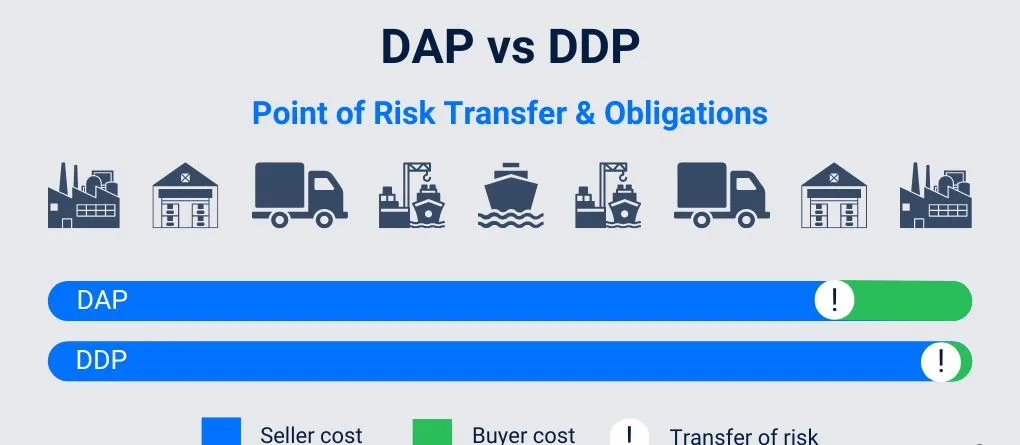
How to calculate shipping costs
Freight costs are usually calculated based on the weight and volume of the goods, the distance to be travelled, and the mode of transport. The greater of the two is usually selected for weight and volume to determine the billing weight.
Distance is another key factor, with long-distance transport usually more expensive than short-distance. And different modes of transport (such as sea, air, and land) have different unit prices.
Freight calculation formula: freight = weight × unit freight + additional
What information is needed to calculate shipping costs?
Place of origin and destination
A package’s distance from its origin to its destination is a key factor affecting shipping costs. The further the distance, the higher the price. Knowing the place of origin and final destination of the package is essential to accurately estimate the cost, which is particularly important in logistics cost management.
Package weight
A parcel’s weight and volume are essential indicators determining the shipping cost. The exact weight is the weighing value of the parcel, while the volume depends on the length, width and height. Logistics companies calculate the space cost of bulky but lightweight parcels based on the volume. By optimizing the packaging size, the volume weight can be effectively reduced, thereby reducing shipping costs and increasing profits.
Packaging size
The dimensions of a package (length, width and height) directly impact transport costs, especially when volume weight is involved. Volume weight is usually calculated by multiplying the dimensions of a package and dividing by a specific cubic divisor. Understanding this rule and designing packaging appropriately can reduce the space a package takes up in the transport vehicle, thereby saving logistics costs and improving operational efficiency.
Transport Transit time
The length of the shipping time directly impacts the cost; the faster the delivery, the higher the price. Standard ground service usually takes 3-7 days, while next-day express delivery is more expensive. When choosing a shipping method, you should weigh the speed and cost according to your needs to ensure that you meet customer expectations while controlling logistics costs.
You may want to know: How Long Does Overseas Shipping Take? A Comprehensive Guide to International Delivery Times
How much is the international shipping fee?
International shipping fees vary greatly depending on the region and shipping method. For example, the fee to ship from Asia to Europe by sea may be different from that to the Americas, depending on factors such as the busyness of the shipping route and port handling charges.
For example, the shipping fee for international express delivery from China to the United States is generally around 3-10 USD per kilogram by air. Still, it may be higher for remote areas or during special periods (such as peak shipping seasons). For shipping by sea, the cost of a 40-foot high cube container from Europe to Africa may be around 2,000-5,000 USD, depending on the type of cargo, the port of origin, the port of destination, and other circumstances..
You may want to know:
- how much for air freight from china to los angeles
- How Much does Shipping Cost from China to Ireland
- How much is shipping from China to Canada?
- Shipping costs from China to the USA explained
Factors affecting shipping costs
- Weight and volume of goods: Heavy or bulky goods usually incur higher costs.
- Shipping method: Air freight is generally more expensive, while sea freight is cheaper but slower.
- Shipping distance: The further the distance, the higher the shipping cost.
- Destination taxes and duties: Policies and taxes in different countries can affect shipping costs.
- Additional fees: These include insurance, packaging, fuel surcharges, etc.
- Seasonal demand: Shipping rates usually rise during peak seasons.
- Shipping company selection: Different companies may have different pricing strategies for shipping rates.
USPS shipping rate calculation standard
The USPS (US Postal Service) has various mail types, such as First-Class Mail, Priority Mail, and Express. First-Class Mail is mainly used for letters and small parcels, and the cost is relatively low. The cost is calculated based on the weight and size (e.g., whether the size of the letter meets the standard envelope size). The starting price is usually a few dollars and the price increases for each additional weight.
| Departure City | City of Destination | Shipping Service | Shipping Speed | Shipping Cost |
| Los Angeles | New York | UPS Next Day Air Early | 1 day | $147.32 |
| Los Angeles | New York | UPS Next Day Air | 1 day | $111.77 |
| Los Angeles | New York | UPS Next Day Air Saver | 1 day | $100.48 |
| Los Angeles | New York | UPS 2nd Day Air | 2 days | $47.70 |
| Los Angeles | New York | UPS 3 Day Air Select | 3 days | $40.09 |
| Los Angeles | New York | UPS Ground | 4 days | $14.09 |
The latest shipping rates can be found using the shipping rate calculator on the USPS website.
FedEx shipping fee calculation standard
FedEx calculates shipping fees based on the billed weight (the greater of the actual weight or the volumetric weight). Its service types include FedEx Express (courier service), FedEx Ground (ground transportation service), etc. For FedEx Express, the speed is fast, and it is suitable for urgent and high-value goods. Shipping fees are based on the billed weight of the package, the distance travelled, and the type of service.
| Departure City | City of Destination | Shipping Service | Shipping Speed | Shipping Cost |
| Los Angeles | New York | FedEx First Overnight | 2 days | $175.76 |
| Los Angeles | New York | FedEx Priority Overnight | 2 days | $139.02 |
| Los Angeles | New York | FedEx Standard Overnight | 2 days | $124.93 |
| Los Angeles | New York | FedEx 2Day AM | 3 days | $77.29 |
| Los Angeles | New York | FedEx 2day | 3 days | $68.20 |
| Los Angeles | New York | FedEx Express Saver | 4 days | $64.43 |
| Los Angeles | New York | FedEx Ground | 6 days | $13.54 |
The latest shipping rates can be found using the shipping rate calculator on the FedEx official website.
UPS shipping fee calculation standard
UPS (United Parcel Service) shipping fees are calculated based on weight, size, and distance. UPS offers various services, such as UPS Next Day Air, UPS 2nd Day Air, UPS Ground, etc. The price for UPS Next Day Air is higher, and it is mainly for urgent packages.
| Departure City | City of Destination | Shipping Service | Shipping Speed | Shipping Cost |
| Los Angeles | New York | UPS Next Day Air Early | 1 day | $147.32 |
| Los Angeles | New York | UPS Next Day Air | 1 day | $111.77 |
| Los Angeles | New York | UPS Next Day Air Saver | 1 day | $100.48 |
| Los Angeles | New York | UPS 2nd Day Air | 2 days | $47.70 |
| Los Angeles | New York | UPS 3 Day Air Select | 3 days | $40.09 |
| Los Angeles | New York | UPS Ground | 4 days | $14.09 |
The latest shipping rates can be found using the shipping rate calculator on the UPS official website.
How to cut transport costs
- Choose the proper transport method: Choose the most suitable transport method based on the balance between timeliness and cost. Sea freight is ideal for large quantities, while air freight suits small amounts and urgent shipments.
- Consolidation and LCL: Ship goods with other companies to share transport costs, suitable for small quantities.
- Optimize packaging: Reduce volume and weight by designing packaging reasonably to reduce transport costs.
- Long-term cooperation: Long-term contracts with logistics companies often result in discounts or preferential treatment.
- Use transport management software: Transport management software (TMS) can optimize transport routes, help choose the best transport company, and reduce unnecessary costs.
- Pay attention to seasonal and market changes: Avoid shipping during peak demand periods (such as before and after holidays) and choose off-season shipping to save on shipping costs.
- Choose the correct tariffs and customs clearance services: Avoid additional costs during customs clearance and use efficient customs clearance services.
- Book a delivery time: Arranging transport in advance and avoiding last-minute rushes often reduce costs.
You may be interested in the following content:




